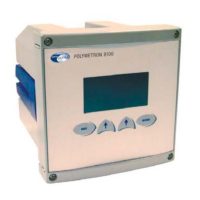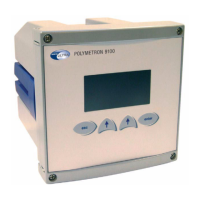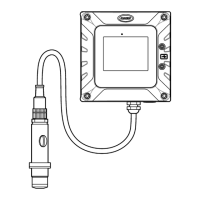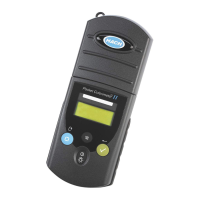5. Select SET FUNCTION>LOGARITHMIC and then select the
applicable options in the ACTIVATION menu.
Option Description
SET 50% VALUE Sets the value corresponding to 50% of the process
variable range.
SET HIGH VALUE Sets the high endpoint (upper value) of the process
variable range.
6. Select SET FUNCTION>BILINEAR and then select the applicable
options in the ACTIVATION menu.
Option Description
SET LOW VALUE Sets the low endpoint of the process variable
range.
SET HIGH VALUE Sets the high endpoint (upper value) of the
process variable range.
SET KNEE POINT
VALUE
Sets the value at which the process variable
range divides into another linear segment.
SET KNEE POINT
CURRENT
Sets the value of the current at the knee point
value.
Relay setup
1. Select SETUP SYSTEM>SETUP OUTPUTS>RELAY SETUP.
2. Select the relay.
3. Select an option.
Option Description
ACTIVATION The menu list items change with the selected function.
Refer to Relay activation options on page 14 for more
information.
SELECT
SOURCE
Selects the output. Options: None (if the relay is not
configured), the analyzer name or calculation (if a
calculation formula has been configured). Refer to Set
up the calculation on page 12.
Option Description
SET FUNCTION Selects a function. ALARM—The relay starts when the
upper or lower alarm value is triggered. FEEDER
CONTROL—The relay shows if a process value is larger
or falls below a setpoint. EVENT CONTROL—The relay
toggles if a process value reaches an upper or lower
limit. SCHEDULER—The relay switches at certain times
independently of any process value. WARNING—The
relay shows warning and error conditions in probes.
SET TRANSFER Selects active or inactive.
FAIL SAFE Selects yes or no.
Relay activation options
1. Select SETUP SYSTEM>SETUP OUTPUTS>RELAY SETUP.
2. Select the applicable relay.
3. Select ALARM in the FUNCTION menu and then select the
applicable options in the ACTIVATION menu.
Option Description
LOW ALARM Sets the value to set the relay to on in response to the
decreasing measured value. For example, if the low alarm
is set for 1.0 and the measured value drops to 0.9, the
relay starts.
HIGH ALARM Sets the value to set the relay to on in response to the
increasing measured value. For example, if the high alarm
is set for 1.0 and the measured value increases to 1.1, the
relay starts.
LOW
DEADBAND
Sets the range where the relay stays on after the
measured value increases above the low alarm value. For
example, if the low alarm is set for 1.0 and the low
deadband is set for 0.5, the relay stays on between
1.0 and 1.5. The default is 5% of the range.
HIGH
DEADBAND
Sets the range where the relay stays on after the
measured value decreases below the high alarm value.
For example, if the high alarm is set for 4.0 and the high
deadband is set for 0.5, the relay stays on between
3.5 and 4.0. The default is 5% of the range.
14 English
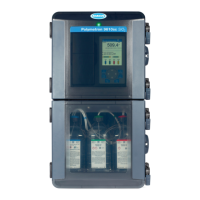
